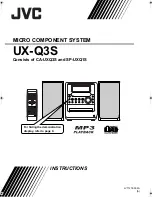
Allen & Heath
11
WZ
4
16:2 and 12:2 User Guide
The
MixWizard uses professional grade 3 pin XLR and 1/4" TRS (3 pole) jack sockets. To ensure best perfor-
mance, we recommend that you use high quality audio cables and connectors, and take time to check for relia-
ble and accurate cable assembly. It is well known that most audio system problems are due to faulty or sub
standard interconnecting leads. The following mating plugs may be used to connect audio signals to the console:
Audio Connections
Avoid reversing + and - on balanced connections as this will result in reversed polarity (out of phase) signals
which may cause signal cancellation effects.
Where long cables runs are required, balanced interconnections should be used. However, line level intercon-
nections between more affordable 2-wire (signal, ground) unbalanced equipment and the console are unlikely to
cause problems if the cables are kept shorter than 10 meters or so. Refer to the wiring diagrams on the oppo-
site page.
Dealing with Ground Loops, Buzz and Interference
For optimum performance all audio signals should be referenced to a solid, noise-free ground (earth) point, fre-
quently referred to as the ‘star point’ or ‘clean earth’.
A ground loop is created when potential differences exist between grounds at different points in the system, and
the signal has more than one path to ground. In most cases ground loops do not result in audible problems.
Should you experience hum or buzz caused by a ground loop, check first that each piece of equipment has its
own separate path to ground. If so, operate ground lift switches on connected equipment in accordance with the
instruction manuals. Alternatively disconnect the cable screen at the destination end only. This breaks the of-
fending loop while keeping the signal shielding down the length of cable.
WARNING For operator safety do not remove the ground (earth) connection in the
power lead of the console or connected equipment.
To avoid interference pickup keep audio cables away from mains power units and cables, thyristor dimmer units,
computer equipment and mobile phones. Where this cannot be avoided, cross the cables at right angles to mini-
mise interference
A note about balanced connections
A differentially balanced connection has two signal wires, (hot) and signal - (cold) and a shield. The signal
source generates positive going polarity down the + wire and negative polarity down the – wire. The destination
input stage accepts the + signal on its non-inverting (+) input pin, but it inverts the – signal, adding it to the +
signal. The result is that the wanted signal is boosted. Now examine what happens when unwanted interference
(hum and noise) is induced into the cable. The noise is induced equally and with the same polarity into both
wires. At the destination input the – wire signal gets inverted and added to the + signal. Because the polarity is
the same on both input wires the noise cancels itself out at this input. For this interference rejection to work it
is important that the source, the cable and the destination input are all balanced. Balancing provides greatest
advantage with low level signals such as those produced by microphones.
An impedance balanced output provides similar interference rejection, but without the signal drive on the - wire.
It does not generate a negative polarity signal at its – output. Instead, the – wire has no signal but is held at the
same impedance as the + wire. This means that both wires pick up the noise equally resulting in cancellation as
described above.
TRS jack plug
TS jack plug
XLR male plug
XLR female plug
RCA phono jacks
2
3
1
1
3
2
Tip
Sleeve
Ring
Tip
Sleeve
USO
RESTRITO
Содержание MixWizard WZ4 12:2
Страница 1: ...USER GUIDE Publication AP8665 MixWizard WZ4 16 2 and WZ4 12 2 USO RESTRITO...
Страница 31: ...USO RESTRITO...
Страница 32: ...USO RESTRITO...












































